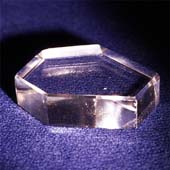 quartz hexagon
quartz hexagon
During August 1993 and January 1999, I performed experiments with a polished slice from a hexagonal quartz crystal (approx 3cm in diameter and 8mm thick) to show, by analogy, the formation of the mock suns (parhelia or sundogs). Water ice is birefringent with only a small difference in refractive index between the O- and E-rays. Quartz, however, has a birefringence of +0.009 which is sufficient to produce double parhelia whose different positions can be seen easily by rotating a polaroid when viewing them on a screen.
This shows a sketch of the light path through the quartz hexagon. With a white light source the projected spectrum is desaturated in the middle due to the birefringence. A polaroid oriented perpendicular or parallel to the dispersion direction isolates each of the spectra in turn.
Illumination of the crystal with white light produces this double spectrum which can be split with a polaroid.
Illumination with a laser produces a double spot (actually a double line in this picture because of optical imperfections in the polishing of the crystal). This composite picture shows the doubled image with and without a polaroid.
Is it possible to see this effect in a real mock sun produced by ice hexagons?
Go to Bob Fosbury's homepage